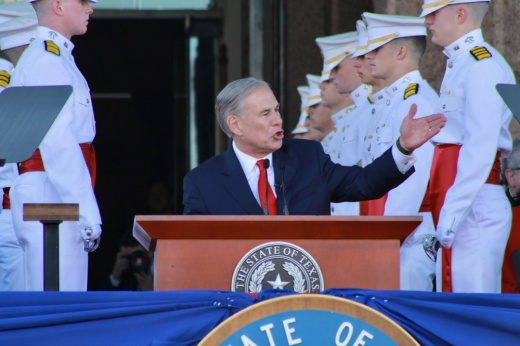Among the governor’s plans are $15 billion for property tax relief and nearly $750 million for school safety. He would also like lawmakers to approve school choice programs, reform the community college finance system, extend postpartum Medicaid coverage to 12 months and develop incentives to continue to attract businesses to Texas.
“To build the Texas of tomorrow, we must continue the state’s unrelenting efforts to build infrastructure, grow the energy sector, improve job training and public education, and ensure health care access—all while keeping Texans safe and preserving the freedoms we enjoy today for future generations,” Abbott said in his proposal.
During Abbott’s State of the State address Feb. 16, he unveiled seven emergency items for the current legislative session: cutting property taxes, ending COVID-19 restrictions “forever,” expanding school choice, making schools safer, tightening bail requirements, increasing border security and tackling the fentanyl crisis.
Because these initiatives are deemed an emergency by the governor, lawmakers can vote on them immediately. Under the Texas Constitution, lawmakers typically cannot vote on or pass legislation until the 60th day of the session—March 10—but they can choose to take up bills related to the emergency items at any time.
Lawmakers have access to $188.2 billion, including a $32.7 billion surplus, as they create the state budget for 2024-25. This is a “once-in-a-lifetime opportunity,” according to Comptroller Glenn Hegar.
“Our mighty Texas economy has produced another record—we now have the largest budget surplus in the history of our state,” Abbott said in the proposal. “But make no mistake, that money does not belong to the government. It belongs to the taxpayers. We will use that budget surplus to provide the largest property tax cut in Texas history.”
Below are some of the plans and programs Abbott wants lawmakers to fund for the next biennium.
Property tax cuts
As inflation increases and the demand for housing grows, property value and taxes do too, Abbott wrote in his proposal. He asked lawmakers to provide “meaningful,” long-term property tax relief to Texans in a few ways.
In the largest use of funds proposed in the document, Abbott asked lawmakers to dedicate $15 billion to lower property tax rates. This aligns with the initial budget proposals in the House and Senate.
He also proposed that senior citizens be automatically enrolled in a $10,000 homestead exemption, pay reduced state fees and have their county property taxes frozen. A homestead exemption is a reduction to a portion of a home’s value for tax purposes.
Public schools
The governor asked lawmakers to create Education Savings Accounts, which would allow parents to receive public funds to cover a variety of educational expenses, including private school tuition, online learning programs, higher education expenses and more.
“Parents deserve the opportunity to choose the educational setting that is best for their child, whether it is a traditional public school, public charter school, private school or home-schooling,” Abbott said in the proposal.
Implementing school choice programs is one of Abbott’s seven emergency items this session. Lawmakers have debated the concept for years, but it has not received enough support for approval during previous sessions.
Abbott also asked lawmakers to reform statewide curriculum standards, support special education programs and teachers, and increase salaries for all educators. He did not suggest specific funding amounts for these initiatives.
School safety
During his State of the State address, Abbott said Texas would work with school districts and the Texas Education Agency to ensure all schools follow “the safest standards.”
In his budget proposal, he addressed the May 24 shooting at Robb Elementary School in Uvalde, during which 19 students and two teachers were killed. State leaders allocated $100.58 million toward school safety initiatives in June, including the expansion of mental health programs and the distribution of resources to law enforcement agencies.
Abbott proposed the use of nearly $750 million in state funds to improve school safety. He asked lawmakers to use at least $600 million to “make necessary school safety improvements,” including technology upgrades, “hardening” equipment and more mental health resources on campuses.
Another $142 million should be used to support the Texas Child Health Access Through Telemedicine program, Abbott said. TCHATT is a telemedicine program that connects students throughout Texas with mental health resources.
Finally, Abbott asked that $6.6 million go to the the Advanced Law Enforcement Rapid Response Training Center, which provides police officers with research-based active shooter training and resources.
Public safety
Among Abbott’s other emergency items are border security and the fentanyl crisis. He asked lawmakers to continue to fund Operation Lone Star, a border security initiative launched by the governor in March 2021.
“While much has been accomplished by the brave men and women at the border, there is still a great amount of work to be done to protect Texans,” Abbott said in the proposal.
In rural communities, many law enforcement agencies have not been able to pay competitive salaries and retain officers, Abbott said. As a result, he asked lawmakers to provide rural communities with $350 million in grants to help them hire, train and pay employees.
Law enforcement agencies that work near the border should also be provided with Narcan, an overdose-reversal drug, Abbott wrote.
“As law enforcement apprehend and arrest dangerous criminals and seize drugs coming across our southern border, they can be exposed to lethal doses of fentanyl,” he said in the proposal. “The use of Naloxone, known as Narcan, can reduce or reverse the effects of opioids.”





